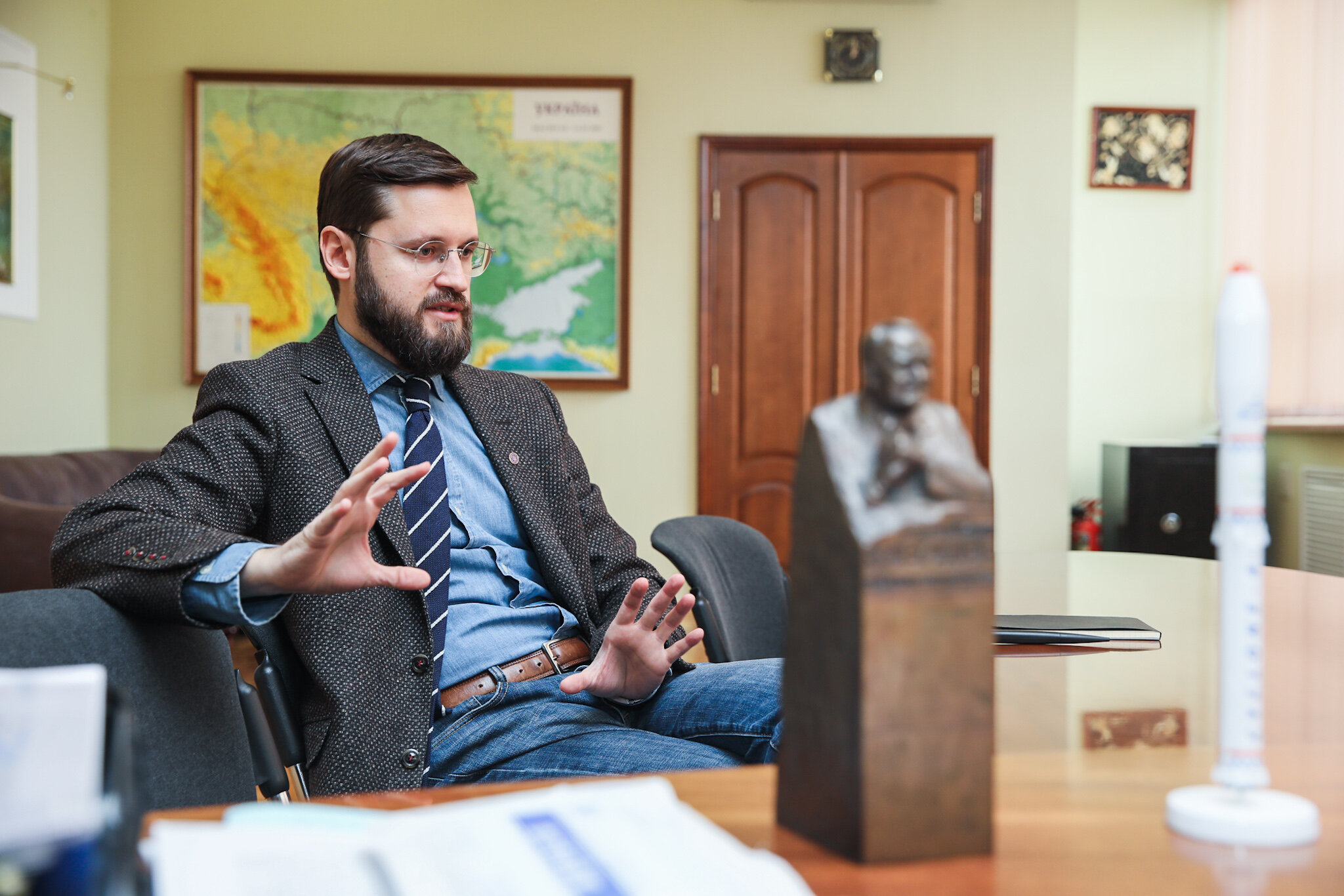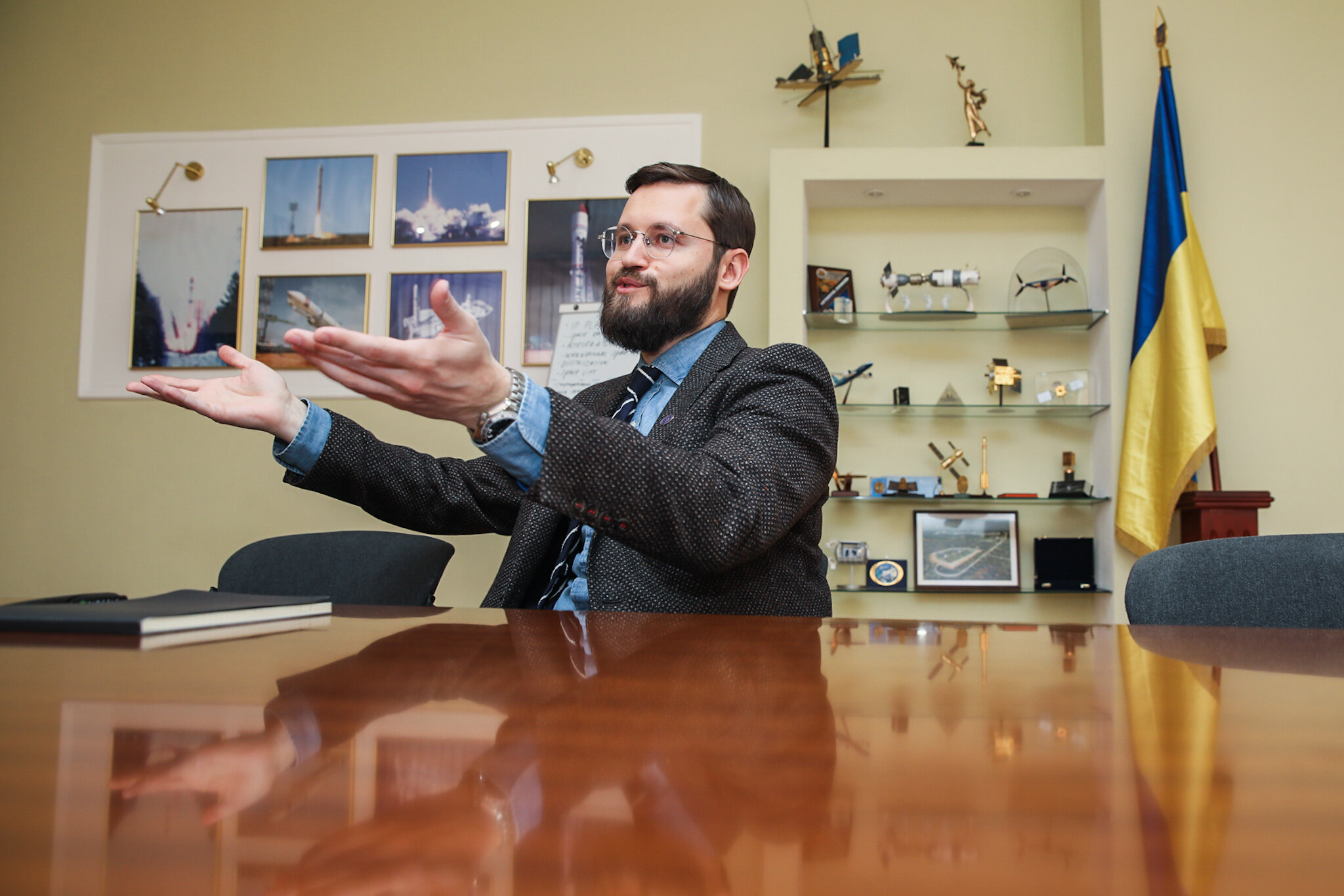Volodymyr Usov, the head of Ukraine’s State Space Agency, keeps a bust of the 35th U. S. President John F. Kennedy at his former office in Odesa.
“I got it from the JFK museum in Dallas,” he says.
“I’m a Kennedy fan, and I begged the museum to sell me that sculpture. They refused. But then I told them JFK had inspired me to work in the space industry in my country, and they gifted it to me, for free.”
Apart from the father of the Moon landing program, Usov also keeps close to himself a sculptured portrait of Serhiy Korolyov — the Ukrainian-born patriarch of Soviet space discovery.
“I want to be always having reminders of success before my eyes,” Usov says about his collection of busts.
“And also reminders of how things must never be done in the space industry,” he adds pointing out to a handy model of Cyclone‑4 launch vehicle placed on his desk.
Cyclone‑4 once was a promising Ukrainian project that failed miserably despite millions spent — another setback marking an inglorious downfall of Ukraine’s aerospace industry, which used to be among the world’s greatest.
Amid raging corruption and lack of interest and investment, it has squandered most of the potential in the last decades. This blistering nosedive has already brought Ukraine to the verge of losing its status of a spacefaring nation forever.
Usov says he came to Space Agency to never let that happen.
His warning is striking: we have only several years to a point of no return.
But there is some good news as well: We still have our last chance to carry out in-depth reforms, resurrect neglected production lines, and give a go to fresh ideas.
Despite the long-time decline, the young Space Agency chief says, Ukraine still has the potential to start offering technologically advanced and low-cost solutions that could be in high demand — and also to turn this industry into a lucrative, money-making business, a locomotive of the national economy.
And his ambitions are as bold as they can possibly be — very up to outpacing Russia in global markets and joining the international endeavor of a new landing on the Moon.

Volodymyr Usov, the head of Ukraine’s Space Agency, talks to the Kyiv Post during an interview in Kyiv on April 27, 2020. (Volodymyr Petrov)
Fall from grace
Usov, 36, took up his duties at Space Agency in February.
Originally from Odesa, he launched Kwambio, a startup working in high-precision 3D printing, in 2014. The company quickly progressed and struck contacts with General Electric, Coca Cola, and Stanley Black & Decker, and also consulted NASA, Tesla, and Airbus.
Usov calls himself “an idea-driven” enthusiast who decided to bow down his thriving business for a higher cause.
“The way it is the case for so many people, space was my dream since my youth,” he told Kyiv Post in his April 27 interview.
“And my goal is to turn Ukraine into a nation making a big contribution in creating stable life support infrastructure in space — for all mankind.”
Things, however, look more than grim on the ground.
Ukraine, particularly its giant spaceship factory Pivdenmash (more commonly known as Yuzhmash) and its Pivdenne (Yuzhnoye) design bureau in the city of Dnipro were one of the Soviet Union’s key centers of the aerospace industry.
It was Dnipro where much of legendary rockets and satellites of the Space Race of the 1950s‑1970s were engineered and produced, in addition to nearly 70 percent of Soviet ballistic missile stockpile.
Today, the sector is so desperate that most people in present-day Ukraine are not actually aware there’s a space agency in the country.
Usov came to an institution that is in critical condition and has been surviving on the edge for decades. According to the agency’s 2019 report, out of 17 enterprises under its control, eight were loss-makers and two were in the process of being dismantled.
The agency’s annual budget is no larger than Hr 500–600 million ($22 million), almost all of which is money for defense production contracts. The agency itself has to deal with no more than $1–2 million a year, according to Usov, while it needs at least Hr 5 billion a year ($190 million) to run more or less serious projects and researches.
In the last three years, Ukraine has basically had no space program at all — the government never approved one.
There are only two big gleams of hope for the whole industry: the Dnipro giants assemble first stage cores for NASA’s rocket Antares lifting payloads to International Space Station (ISS). Another big contract is the production of cruise propulsion engines for the European Space Agency’s (ESA) rocket project Vega.

This NASA handout photo shows a Northrop Grumman Antares rocket as it rolls out to Pad-0A, on April 15, 2019 at NASA’s Wallops Flight Facility in Virginia. (AFP PHOTO / NASA / BILL INGALS)
Time running out
But behind that, once glorious spaceship factories are drowning in massive wage arrears, personnel cuts, and lack of contracts.
In many ways, as Usov says, this is happening because the whole industry is still managed as if it exists in the Soviet administrative command system.
The system has stayed the same for 30 years. It functioned somehow, released some production — and consumed enormous resources with little or no results at all. Way too many people were quite happy with this status quo.
“For instance, the Cyclone‑4 project, which was supposed to give us a rocket and a space launch complex, has lasted 15 years, with $1 billion spent,” Usov said.
“No one has spent so much on a new rocket complex since the Moon landing project. $350 million was spent on the Lybid satellite (planned for launch since 2011), and it is still located in (Russia). Whether we can launch it from there is a question with no answer.”
“So if we see that over $1 billion has been spent on projects that gave us nothing, it becomes obvious why this system functioned and who benefitted for it.”
In the 21st century, the quasi-Soviet management system doomed to fall, he added.
In Ukraine in 2020, space enterprises still have no control of their own assets, they can’t entice investors by themselves, or get rid of their enormous surplus facilities that exhaust their resources in vain.
And they are enormously ineffective, too: “If to produce a launch vehicle, you actually need 1,000 personnel and $120 million, you can’t spend $350 million with 5,000 personnel — this is not effective,” as Usov said.
Since very Soviet times, the whole industry has never been truly reorganized to fit the modern global market of competition and thoughtful resource spending instead of Soviet-style no-matter-the-cost mass manufacturing for World War III.
Another global issue that is about to spell the end to the industry employing 16,000 people is a massive drain of valued specialists.
“A lot of enthusiasts work in this industry (in Ukraine),” Usov said.
“There are dynasties continuously working at the enterprises for decades. And over the last decade, they clearly hold on for their jobs only because of their sense of dignity and respect to Ukraine’s space industry, and patriotism. But this can’t last forever, any enthusiasm will end at some point.”
An average Ukrainian space engineer is now paid as little as Hr 14,000 ($520) a month. And meanwhile, private aerospace companies arising in scores every year are ready to pay them 2–3 times that value right from the start in Ukraine, and 5–6 times that value abroad — especially when it comes to English-speaking engineers.
Skilled workers are leaving Ukraine’s space industry — and this is what is happening right now at a growing pace.
“If (a reformed system) does not get launched in Ukraine within two years and specialists still have no chance to work in big projects with decent salaries, then all that remains will be cold factory workshops,” Usov said.
“There will be simply no one left to be building new engines and rockets.”

Volodymyr Usov, the head of Ukraine’s Space Agency, talks to the Kyiv Post during an interview in Kyiv on April 27, 2020. (Volodymyr Petrov)
Fresh start
Usov intends to transform the severely outdated industry into a national aerospace ecosystem of 30–50 companies, both private, state-run, and mixed. All of them will be able to cooperate, compete, and enter the global market with their projects.
Aerospace giants for the first time will get a chance to work like businesses, not voiceless contractors.
“We want to get rid of the model of Soviet ministry managing enterprises in favor of a model in which enterprises are controlled by their own senior executives,” Usov said.
“The agency, meanwhile, must shape and perform policies — it’s all that simple. It’s a global practice: developing a space program, digesting cutting-edge technologies, international cooperation, procurement of innovative technical solutions.”
This reform will be supplemented with two instruments: an IP platform tacking stock of the industry’s intellectual properties, and a business accelerator.
The IP platform will allow for revealing ideas and projects that state enterprises have no resources for, and for inviting other companies to contribute to executing such concepts.
And the business accelerator is to be giving a boost to young perspective aerospace companies in their early projects — something that Usov’s own business had a very positive experience with in the U.S., in his words.
Thus, if 5–10 new manufacturers are launched annually, Ukraine will get a full-fledged aerospace cluster in five years. And, Usov added, the strategy of fresh start requires investing nearly 500,000 euros a year in new space startups, which is quite affordable for Ukrainian state budged, especially if NASA and ESA contribute.
New successful private producers, such as famous Ukrainian-American aerospace company Firefly, will be more than welcome to participate in new space programs, the head assured.

Zenit-3SL produced by rocket Ukraine’s Yuzhmash plant preparing to start from the Baikonur Cosmodrome in Kazakhstan.
More than exploration
Gone are the days when space exploration was a matter of international prestige or ideological competition of superpowers.
Today, space is a very real, money-making business that goes far beyond rockets and satellites and grows exponentially with every year.
People need to go into space, as the whole global industry behind this generates an enormous amount of money, jobs, taxes, and surplus value.
Ukraine at the same time is blessed to be still having two valuable things: unique space technologies, such as the full circle of production of rockets, and talented engineers with ideas. And right now there’s a narrow window of opportunity for Ukraine for stepping in the global space industry market, as Usov said.
“People often say ‘Why do we need space, it is expensive and not affordable for a poor country’,” the agency head said.
“But the space industry can and must be a multiplier of economic growth. And not only for rocket and satellite building but also for related sectors: machinery, transport, power industry.”
Even now there is a lot to offer to the world.
The head confirmed that Ukraine intended to join NASA’s $35-billion program Artemis, which plans to return humans to the Moon in 2024 and establish the first inhabited lunar base after 2028.
Such a massive international project is expected to trigger an outbreak of technological outburst.
Right now, the Pivdenne bureau has a ready project of a lunar industrial base, which it expects to be its contribution to the Artemis program. Also, the Ukrainian space industry will propose technological decisions for lunar orbital stations, as well as for transport communications between the Moon surface, orbital stations, and the Earth, Usov said.

A picture of Earth in sunlight taken by astronaut Nick Hague from the board of International Space Station on Oct. 2, 2019. (AFP)
Ukraine’s trademark
In the case of effective management, Ukraine’s space industry can create enormous business opportunities. Among them is providing services in air launches to orbit via the power of heavy airlifts like legendary Antonov An‑225 Mriya, the world’s biggest cargo aircraft initially designed for airborne space launches.
This method is way cheaper than a usual rocket start and is still a rare technology in the world, and Ukraine would have a lot of clients willing to save money on satellite launches. If this technology is resurrected, Ukraine will for the first time obtain its own path into space, as constructing Ukraine’s own spaceport is not possible.
The same way, the agency wants to allocate $50 million on creating a network of six high-precision observation satellites called Oko (“The Eye”) and to render services to Ukrainian authorities, including regarding issues of national security, as well as private clients.
Thanks to possessing technologies of the complete production of rockets and components, there’s even an opportunity to snatch some multimillion contracts from Russia.
For instance, the Space Agency wants to start producing the first stage of the Antares with Ukrainian engines without Russian-produced engines NK‑33, thus providing NASA with a full rocket stage built exclusively by Ukraine.
“This would be cheaper and more convenient for (NASA), and Russia is under sanctions now. So we will resolve a lot of political and financial problems,” Usov said, adding that while Russia sold its engines to the U.S. for $16 million, Ukraine would be able to propose a $12 million design.
Ukraine has a chance still, he added, but action must be taken within the next 2–3 years — otherwise the rapidly growing global will outpace it completely, and Ukraine will kiss its space status goodbye forever.
To prevent that from happening, Usov assumes an extremely ambitious goal: To eventually bring Ukraine’s Space Agency up to the world’s top five space policymakers.
Even the very face of the agency must get away from its obsolete Soviet-style flavor. According to Usov, he intends to launch the agency’s complete rebranding giving it a more inspiring, and forward-looking image.
Among variants contemplated for the agency’s new name is “UASA” — the unapologetic attempt on NASA’s brand.
The very perception of the national space industry must see a positive change. And together with hopeful successes in reforms and markets, Usov also plans to initiate the mass production of the Space Agency merchandise: Toys, branded t-shirts, figures, and many more.
“Ukrainian aerospace should become a fancy and cool thing because it deserves this,” he said.
“Hopefully, if we do everything right, foreigners at some point will start bringing models of spacecraft and satellites to their home countries as souvenirs from Ukraine.”
“I just want space to be the biggest trademark of Ukraine.”

Volodymyr Usov, the head of Ukraine’s Space Agency, talks to the Kyiv Post during an interview in Kyiv on April 27, 2020. (Volodymyr Petrov)
